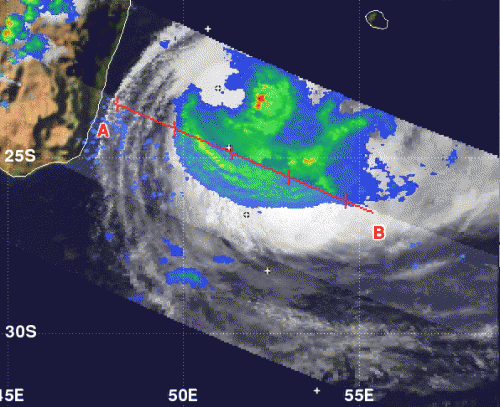NASA sees the falling of Cyclone Felleng

Cyclone Felleng traveled through the Mozambique Channel during the week of Jan. 28, 2013 and emerged south into the Southern Indian Ocean where it transitioned into a cold core low pressure area. NASA's TRMM satellite captured a look at the rainfall rates occurring in Felleng as it was making that transition on Feb. 1.
NASA's Tropical Rainfall Measuring Mission (TRMM) satellite flew over Cyclone Felleng on Feb. 1 at 1648 UTC (11:48 a.m. EST) as it was exiting the Mozambique Channel and becoming extra-tropical. TRMM measured a small area of heavy rainfall east of the center of circulation where rainfall was occurring at 2 inches (50 mm per hour). Most of the precipitation wrapped from northeast to south to west of the center and was moderate, falling at a rate of 1.18 to 1.5 inches (30 to 40 mm) per hour. The northwestern quadrant had very little rainfall at the time of the TRMM overpass.
The Joint Typhoon Warning Center (JTWC) , the organization that forecasts tropical cyclones in the Southern Indian Ocean, issued their final advisory on Cyclone Felleng on Feb. 3 at 2100 UTC (4 p.m. EST). At that time, Felleng's maximum sustained winds were near 40 knots (46 mph/74 kph. Felleng was located about 745 nautical miles (857 miles/1,380 km) south of La Reunion Island, near 33.4 South and 54.3 East. Felleng was moving to the south-southeast at 15 knots (17.2 mph/27.7 kph).
By Monday, Feb. 4 at 0600 UTC Felleng had completed its extra-tropical transition, and the storm's maximum sustained winds continued near 40 knots (46 mph/74 kph). Felleng's center had moved to 31.1 south and 52.8 east, about 605 nautical miles (696.2 miles/1,120 km) south-southwest of La Reunion Island. Felleng continues to move south-southeast in the open waters of the Southern Indian Ocean where it is expected to dissipate in the next couple of days.
Provided by NASA's Goddard Space Flight Center




















